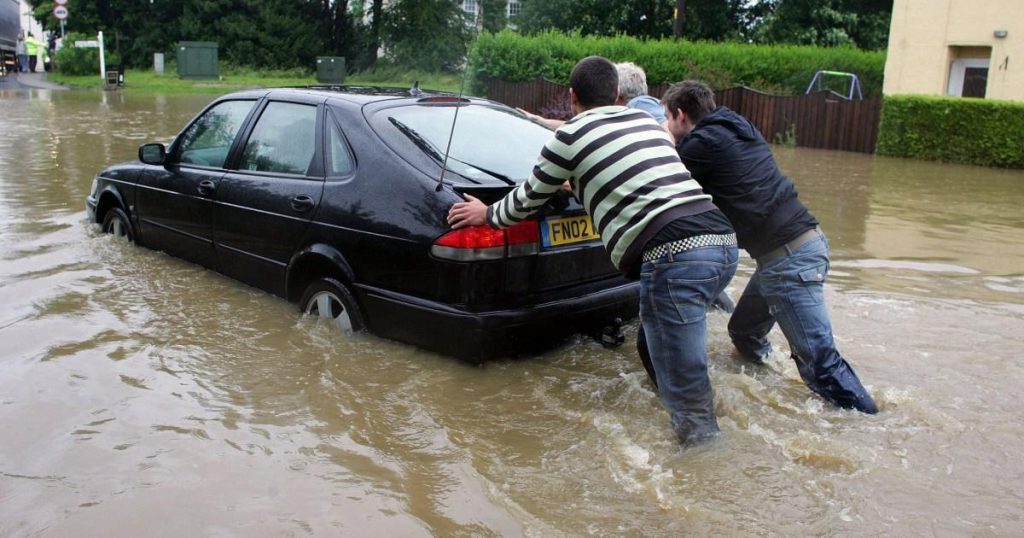The dawn of 2025 brought with it not the promise of new beginnings, but the familiar, unwelcome reality of severe weather disruptions across the United Kingdom. Heavy rain and strong winds, continuing from the previous two days, unleashed travel chaos, impacting road and rail networks and prompting widespread warnings from meteorological and transport authorities. An amber weather warning, signifying potential danger to life, was issued for parts of northwest England, alongside numerous yellow warnings covering areas extending from Scotland to southern England. The combined force of torrential rain, powerful gales, and in some areas, snow and ice, made journeys treacherous and, in many instances, impossible.
The Met Office, the UK’s national weather service, issued dire warnings regarding the intensity and duration of the adverse conditions. Predictions included up to 100mm of rainfall and wind gusts reaching 60mph. These forecasts, coupled with over 120 flood warnings, painted a grim picture for travellers. Major motorways, including the M6 and M56, experienced significant congestion caused by flooding and lane closures. The A628, a crucial trans-Pennine route, suffered similar disruptions. Images circulating on social media depicted vehicles struggling through floodwaters and sections of motorways submerged, emphasizing the severity of the situation.
The railway network faced its own set of formidable challenges. Floodwater inundated tracks in the Manchester and Liverpool areas, bringing TransPennine Express services to a grinding halt. The operator announced the complete cancellation of routes between several major cities, including Liverpool, Newcastle, Hull, Sheffield, Manchester Airport, Redcar Central, Manchester Victoria, Scarborough, Manchester Piccadilly, and York. The absence of replacement bus services further compounded the problems for passengers, leaving many stranded or facing significantly extended journey times. East Midlands Railway services were also affected by the flooding, adding to the widespread travel disruption.
The Met Office, recognizing the hazardous conditions, issued guidance for driving in heavy rain and strong winds. This advice included reducing speed, increasing stopping distances, and using dipped headlights. The organization also stressed the importance of checking weather forecasts and travel updates before embarking on journeys. The amber warning for northwest England, valid until 9:00 am on January 1st, underlined the potential risks to life and property. The disruption caused significant inconvenience for commuters attempting to return to work after the New Year holiday and for those still making their way home from New Year’s Eve celebrations.
Detailed reports from various news outlets and transportation authorities provided a granular view of the unfolding crisis. National Highways, responsible for England’s motorways and major A roads, highlighted several specific locations experiencing severe flooding, including the M56 in Cheshire, where floodwater forced the closure of sections between junctions 6 and 8. The M6, another major artery, faced lane closures between junctions 19 and 18. These closures and restrictions resulted in substantial delays, impacting both passenger and freight traffic. The widespread disruption underscores the vulnerability of the UK’s transport infrastructure to extreme weather events, which are becoming increasingly frequent due to climate change.
The New Year’s Day deluge served as a stark reminder of the challenges posed by severe weather. The disruption highlighted the interconnectedness of transport networks and the cascading impact of localized flooding on wider travel patterns. While emergency services and transport operators worked tirelessly to mitigate the effects of the storm, the extent of the flooding and the widespread nature of the disruptions created a challenging situation for many. The events of January 1st, 2025, served as a potent reminder of the need for robust infrastructure and effective emergency planning to cope with the increasing frequency and intensity of extreme weather events. The widespread disruption also underscored the importance of individual preparedness, including staying informed about weather warnings, planning alternative travel routes, and taking necessary precautions when venturing out during severe weather.




